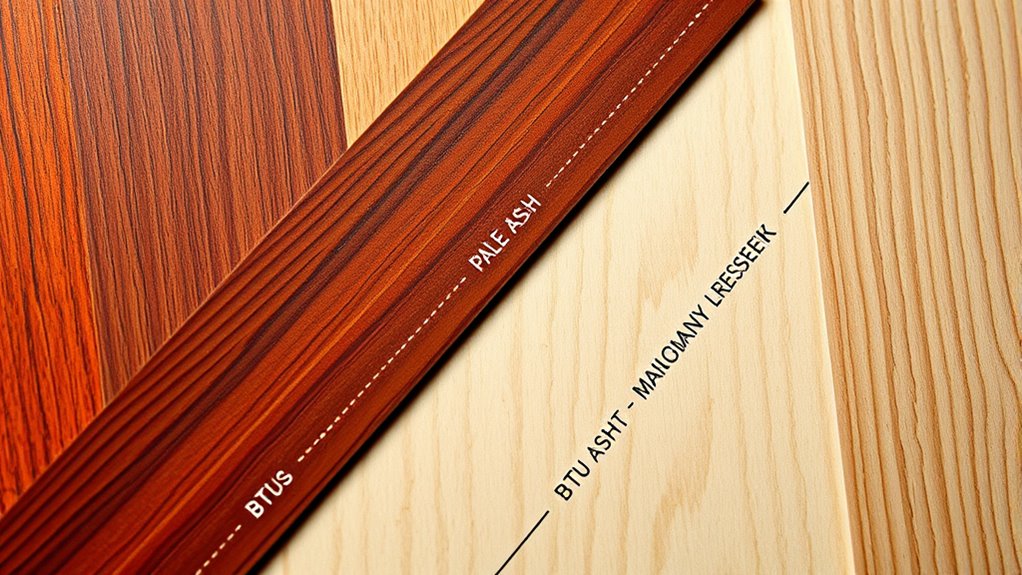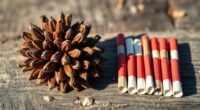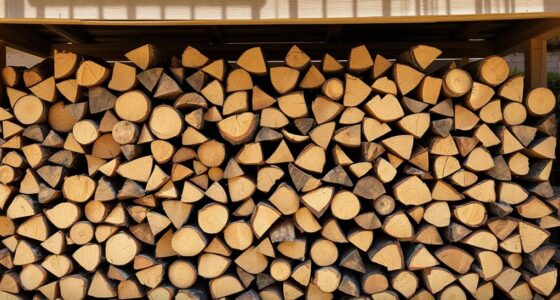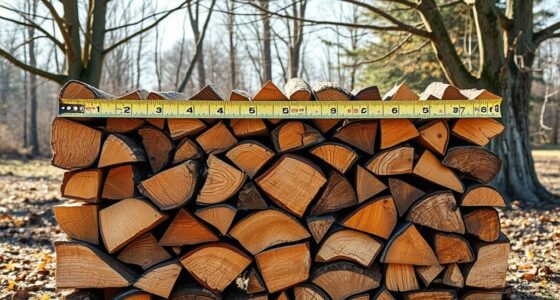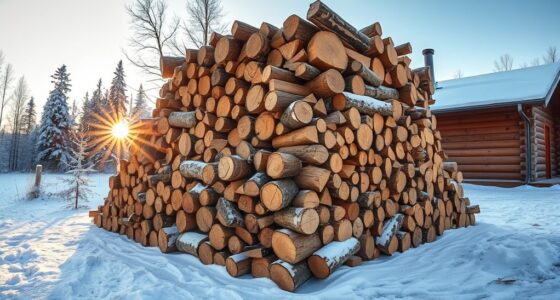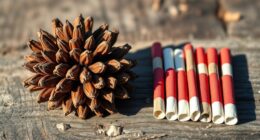Understanding wood density and BTU charts helps you choose the best firewood for efficient heating. Heavier, denser woods like oak or hickory produce more heat per volume, but moisture content also matters—wet wood burns less efficiently. Properly dried, seasoned wood maximizes energy output and BTUs. By knowing how these factors interact, you can optimize your firewood selection and burning practices. Keep exploring, and you’ll discover ways to get the most heat from your wood.
Key Takeaways
- Wood density determines the energy content per volume, affecting the BTU output during combustion.
- Moisture content significantly reduces effective BTUs; properly seasoned wood yields higher heat.
- BTU charts illustrate how different wood types and moisture levels influence heat output.
- Dense hardwoods like oak produce more BTUs than softer woods, but moisture must be controlled.
- Understanding these factors helps optimize wood selection and improve heating efficiency.
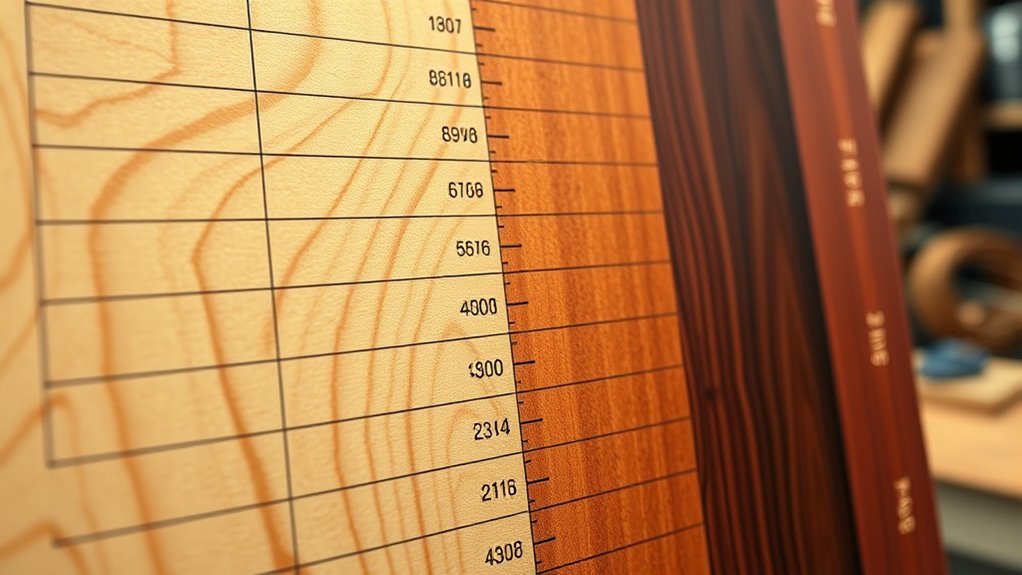
Understanding the relationship between wood density and BTU output is essential for anyone involved in heating, woodworking, or energy planning. When you know how dense a piece of wood is, you can better estimate how much energy it will produce during combustion. Wood density directly influences the amount of heat, measured in BTUs, that you can generate from burning it. The denser the wood, the more energy it contains because it packs more material into a smaller volume. However, this is not the only factor at play; moisture content considerably impacts how efficiently your wood burns and how much heat it produces.
Wood density determines potential heat output, but moisture content significantly impacts combustion efficiency and BTU production.
Moisture content, or the amount of water held within the wood fibers, affects wood combustion. When wood contains a high moisture level, much of the energy from burning goes into evaporating water rather than producing heat. As a result, wet wood produces fewer BTU output than dry, well-seasoned wood of the same density. To maximize heat output, you need to understand how moisture content influences combustion efficiency. Properly dried or seasoned wood with low moisture content allows for cleaner, more complete combustion, releasing more of the stored energy as heat.
In practical terms, if you’re selecting wood for heating purposes, consider both the density and moisture level. Hardwoods like oak or hickory are naturally dense and tend to produce higher BTUs, but they must be properly dried to reach ideal energy output. Softwoods, such as pine, are less dense and generally produce fewer BTUs, but if they’re properly seasoned, they can still be a good fuel source. The key is balancing density with moisture content to ensure efficient combustion. If you burn wood with high moisture, you’re wasting potential energy, and your heating might be less effective. Additionally, properly stored wood helps maintain its quality and reduces the risk of mold or decay that can affect burning efficiency.
Understanding these factors helps you make smarter choices about your wood supply and combustion process. It also allows you to interpret BTU charts more accurately, which typically list the energy output based on specific wood types, densities, and moisture levels. Recognizing that moisture content can drastically alter the BTU output ensures you don’t overestimate your fire’s heat. Proper seasoning techniques, such as air-drying or kiln-drying, can significantly improve combustion efficiency and energy yield. This knowledge empowers you to select the right wood, season it properly, and enhance your burning process for maximum heat with minimal waste. It is also beneficial to understand how wood density charts can assist in selecting the best wood for your needs. Properly understanding combustion efficiency and the role of moisture content allows you to optimize your heating system and reduce fuel costs. Ultimately, appreciating how wood density and moisture content interplay gives you better control over your heating efficiency and energy use, saving you money and reducing environmental impact.
Frequently Asked Questions
How Does Moisture Content Affect Wood Density and BTU Ratings?
Moisture content substantially impacts wood density and BTU ratings. As moisture increases, wood becomes less dense and produces fewer BTUs, reducing its heat efficiency. Drying methods like air drying or kiln drying lower moisture levels, enhancing wood’s energy output. You should always consider moisture impact when selecting wood for burning, ensuring proper drying to maximize energy and heat output. Proper drying improves BTU ratings and overall burning performance.
Are Certain Wood Species Better for High BTU Output?
Certain species surpass others in delivering higher heat output, so you should favor dense, durable woods like oak or hickory for maximum BTU benefits. When doing a species comparison, pay attention to density measurement—denser woods generally burn longer and hotter. Choosing the right wood species can notably enhance your heating efficiency, ensuring you get the most warmth and value from every burn.
Can Wood Density Charts Predict Heating Efficiency Accurately?
You can’t rely solely on wood density charts to predict heating efficiency accurately because of density variability within species and chart limitations. These charts provide general estimates, but factors like moisture content and wood condition affect actual BTU output. To get a better idea of heating efficiency, consider measuring actual burn qualities or using multiple data sources rather than depending entirely on density charts.
How Does Wood Aging Influence Its BTU Value?
Aging wood can dramatically boost its BTU value, like turning a weak twig into a mighty oak! During the aging process, wood’s moisture content drops, making it burn hotter and longer, showcasing its true longevity. As it ages, the wood’s density increases, enhancing heat output. So, the longer you let your wood age, the more powerful and efficient your fires become, transforming your heating experience dramatically.
What Safety Considerations Are Linked to High BTU Woods?
When handling high BTU woods, you should be aware of potential fire hazards, as their higher heat output can increase the risk of accidental fires. Always store these woods in a cool, dry, well-ventilated area away from flames or heat sources. Use proper fire safety measures, like keeping fire extinguishers nearby, and guarantee safe storage practices to prevent accidents and maintain overall safety.
Conclusion
Understanding wood density and BTU charts helps you choose the right fuel for your needs. Did you know that dense hardwoods like oak can produce up to 28 million BTUs per cord, almost double that of lighter softwoods? This means you get more heat from fewer logs, saving you time and money. By using these charts, you make smarter, more efficient choices, ensuring your fire burns longer and hotter every time.

